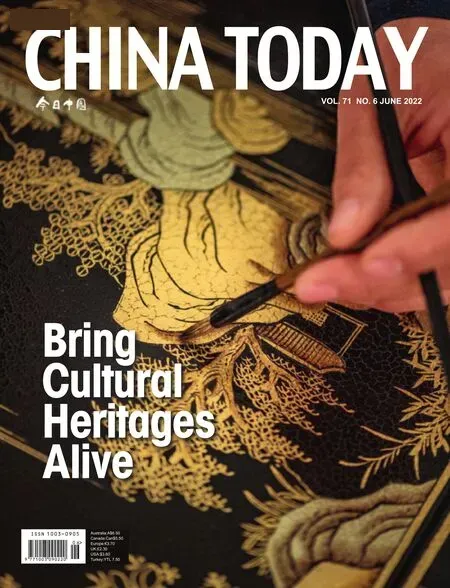Relics from the Warring States Period
The Warring States Period (770-476 BC) was a period not only of incessant wars,but also of rapid economic growth and cultural prosperity.To maintain their rule and contend with each other in wars of annexation,rulers of the feudal states were compelled to strengthen their economy through large-scale production.The new social system and growing economy expanded the people’s horizons and liberated their minds in many ways.ln the ideological realm,a lively situation where “a hundred schools of thought contend” came into being.ln the realm of arts,unprecedented vitality and creativity were released.New progress was also made in medicine and natural sciences,as discoveries and inventions went far ahead of those in other parts of the world.
REFORMS undertaken by various states led to rapid economic development.Agricultural production increased in a way that brought unprecedented prosperity to merchants and artisans.With the development of trade,cities that were once political and military citadels now became industrial and commercial centers.In the mid-Warring States Period,warring states began minting large quantities of coins and setting up their own systems of weights and measures in order to meet the growing needs of trade.
Improved iron-smelting and steel-making technology and the extensive use of iron tools played an important role in rapid economic development.Sharp and sturdy iron tools helped improve agricultural technology and were proved useful for intensive cultivation,ditch digging,construction of dams and other large water conservancy projects,raising the output of handicrafts during and after the mid-Warring States Period.
Unearthed bronze wares of the Warring States Period include a small number of religious ritual vesselsand a larger number of articles used in daily life with realistic designs.By this period of history,a variety of techniques had become available,including split-mold casting,welding,and die casting.Crafts requiring fine workmanship such as engraving,inscribing,mounting,inlaying,and gilding reached new heights as well.

Bronze horsehead inlayed with gold and silver,once an ornament on the shaft of a carriage,unearthed at Guwei Village,Huixian County,Henan Province in 1951.

Silver belt fastener with gold plating,inlayed with jade and glazed pearls,unearthed from Tomb No.5 in Guwei Village,Huixian County,Henan Province in 1951.
Lacquer wares with an inlaid metal hoop around the mouth appeared during the late Warring States Period.This technique not only gave rise to more durable articles but also enhanced their decorative designs.
During this period,learning was no longer monopolized by feudal officials.Private schools were set up all over the country,and it became a vogue to support learned people.Representatives of different schools wrote books,put forward theories,discussed politics,expounded philosophical principles,debated,and tried to influence each other.This was known as “contention of a hundred schools of thought.”
New achievements were also recorded in such disciplines as astronomy,optics,geoscience,and agronomy.
Selected fromA Journey into China’s Antiquity:Chinese History in Cultural Relics
Compiled by National Museum of China Published by Blossom Press

Small black lacquer table with vermilion designs.

Ejin Banner’s goldinlaid bronze tallies,once permits for land and water transportation,unearthed from Qiujia Garden,east of Shouxian County,Anhui Province in 1957.

Opaque colored glass ball,an ornament from the Warring States Period with a vertical diameter of 6.3 cm.

Jade pendants,ornaments unearthed from Tomb No.1 at Leigudun,Suixian County,Hubei Province in 1978.

Bronze seashell coins,known as “ghost-face money,” unearthed in Shouxian County,Anhui Province.

